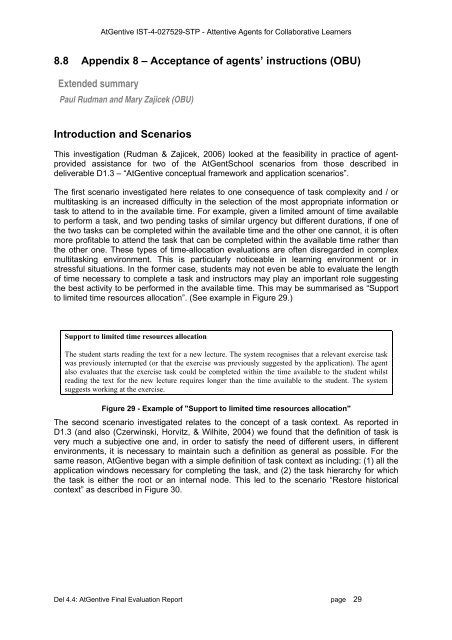Deliverable 4.4 - INSEAD CALT
Deliverable 4.4 - INSEAD CALT
Deliverable 4.4 - INSEAD CALT
You also want an ePaper? Increase the reach of your titles
YUMPU automatically turns print PDFs into web optimized ePapers that Google loves.
AtGentive IST-4-027529-STP - Attentive Agents for Collaborative Learners8.8 Appendix 8 – Acceptance of agents’ instructions (OBU)Extended summaryPaul Rudman and Mary Zajicek (OBU)Introduction and ScenariosThis investigation (Rudman & Zajicek, 2006) looked at the feasibility in practice of agentprovidedassistance for two of the AtGentSchool scenarios from those described indeliverable D1.3 – “AtGentive conceptual framework and application scenarios”.The first scenario investigated here relates to one consequence of task complexity and / ormultitasking is an increased difficulty in the selection of the most appropriate information ortask to attend to in the available time. For example, given a limited amount of time availableto perform a task, and two pending tasks of similar urgency but different durations, if one ofthe two tasks can be completed within the available time and the other one cannot, it is oftenmore profitable to attend the task that can be completed within the available time rather thanthe other one. These types of time-allocation evaluations are often disregarded in complexmultitasking environment. This is particularly noticeable in learning environment or instressful situations. In the former case, students may not even be able to evaluate the lengthof time necessary to complete a task and instructors may play an important role suggestingthe best activity to be performed in the available time. This may be summarised as “Supportto limited time resources allocation”. (See example in Figure 29.)Support to limited time resources allocationThe student starts reading the text for a new lecture. The system recognises that a relevant exercise taskwas previously interrupted (or that the exercise was previously suggested by the application). The agentalso evaluates that the exercise task could be completed within the time available to the student whilstreading the text for the new lecture requires longer than the time available to the student. The systemsuggests working at the exercise.Figure 29 - Example of "Support to limited time resources allocation"The second scenario investigated relates to the concept of a task context. As reported inD1.3 (and also (Czerwinski, Horvitz, & Wilhite, 2004) we found that the definition of task isvery much a subjective one and, in order to satisfy the need of different users, in differentenvironments, it is necessary to maintain such a definition as general as possible. For thesame reason, AtGentive began with a simple definition of task context as including: (1) all theapplication windows necessary for completing the task, and (2) the task hierarchy for whichthe task is either the root or an internal node. This led to the scenario “Restore historicalcontext” as described in Figure 30.Del <strong>4.4</strong>: AtGentive Final Evaluation Report page 29
















